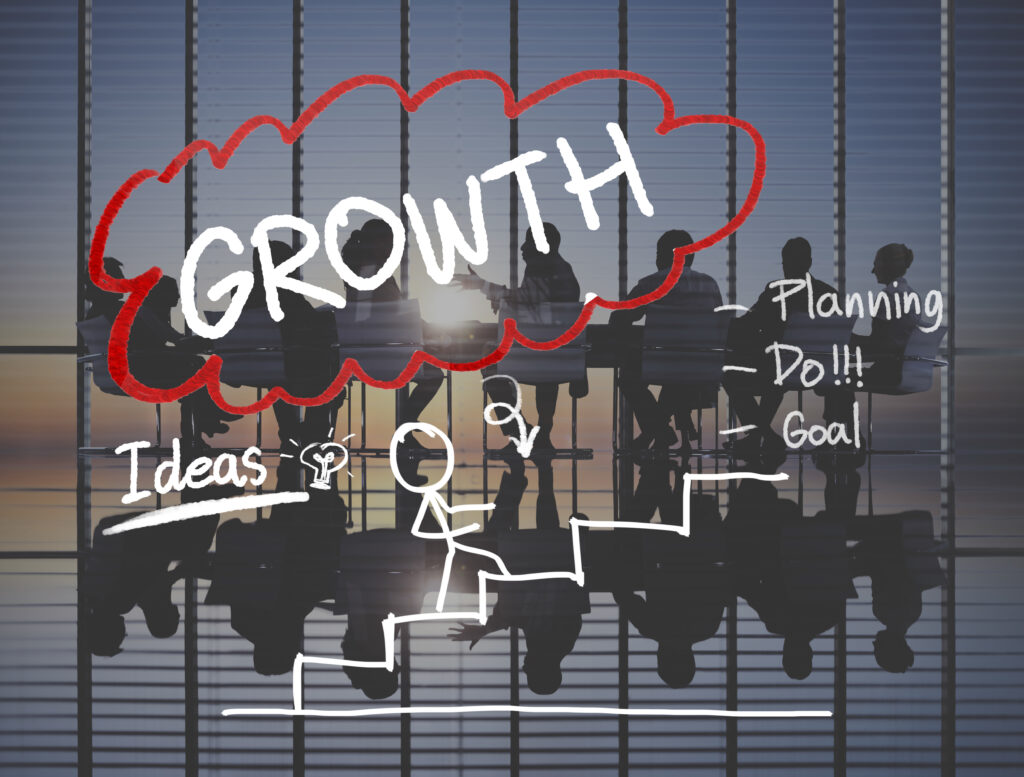
Every successful business follows a growth trajectory, but navigating each phase requires different strategies, mindsets, and operational approaches. Based on my analysis of hundreds of case studies and business growth models, I’ve identified seven critical stages that determine whether a company stagnates or scales successfully.
This isn’t just theoretical—understanding where you are in this progression helps you allocate resources wisely, anticipate challenges, and make strategic decisions that compound over time. Let’s examine each stage in depth, with clear action plans for progression.
Stage 1: Seed Stage (Conceptualization) – Where Vision Meets Validation

The seed stage is where entrepreneurial dreams take their first breath but it’s also where most stumble by confusing enthusiasm for market demand. At this critical juncture, your primary mission isn’t to build the perfect product, but to ruthlessly validate whether your solution solves a real, urgent problem for a specific audience. The most successful founders treat this phase like a scientific experiment, conducting dozens of customer interviews to identify genuine pain points rather than hypothetical needs. They create “minimum viable” tests whether a landing page, prototype, or service pilot—to measure real-world response before committing significant resources. This disciplined approach prevents the common pitfall of building something nobody wants, which CB Insights found accounts for 35% of startup failures.
To progress beyond this stage, you need more than just positive feedback you need measurable evidence of product-market fit. This comes when at least 40% of surveyed customers say they’d be “very disappointed” without your solution (a benchmark from the Mom Test methodology). You should also identify a core group of “early evangelists”—not just satisfied users, but passionate advocates willing to provide testimonials or referrals. Financial validation is equally crucial; successful seed-stage companies establish pricing models that customers accept and that deliver healthy gross margins (typically 50-70% for scalable businesses). Only when these elements align—proven demand, passionate early users, and viable economics—should you progress to the startup phase, where execution becomes the priority.
The Reality
You’re operating on hypotheses. According to CB Insights, 42% of startups fail because there’s no market need—making validation your primary focus.
What You Should Be Doing:
- Carry out a minimum of 50 customer discovery interviews to validate key assumptions.
- Build a minimum viable product (MVP) that solves one core problem exceptionally well
- Establish key metrics for validation (e.g., conversion rates, customer willingness to pay)
Click here to learn more about how to create an MVP
How to Progress
Transition happens when you achieve product-market fit when at least 40% of customers say they’d be “very disappointed” without your solution (per the Mom Test). At this extent, you should have
- Clear customer personas
- Validated pricing model
- Documented value proposition
Stage 2: Startup Stage (Survival Mode)

At this critical juncture, your business has moved beyond the idea phase and is now facing the harsh realities of the market. Cash flow management becomes your lifeline a study by U.S. Research from U.S.Data shows 82% of early-stage startups fail because of poor financial controls, making treasury management the single most crucial survival skill for new ventures. This underscores why disciplined fiscal stewardship must become your top priority. To navigate these treacherous waters successfully, you need to accomplish two fundamental objectives simultaneously: establishing predictable revenue generation while maintaining strict control over operating expenses.
The most effective safeguard? Make your dollars accountable. Implement a weekly financial health check that leaves no transaction hidden – because survival depends on knowing exactly where every dollar comes from and where it goes. Many successful founders, like the creators of Mailchimp, credit their survival to extreme fiscal discipline during this phase, often bootstrapping while deliberately avoiding premature scaling.
To progress beyond survival mode, you need to identify and double down on what’s working. This means analyzing your customer acquisition channels to determine which delivers the highest ROI, then reallocating resources accordingly. Document every successful sales process and customer interaction these will become your playbook for growth. The transition signal comes when you achieve operational sustainability: when recurring revenue not only covers expenses but provides a 25% buffer, when you’ve systematized your core operations, and when you’ve reduced customer churn below industry averages. This creates the foundation needed to shift from scrambling for survival to strategic growth planning.
| Week | Opening Balance | Cash In (Accounts Receivable) | Cash Out (Fixed/Variable) | Net Movement | Closing Balance | Runway Alert |
|---|---|---|---|---|---|---|
| 1 | $85,000 | $12,500 | $28,000 | -$15,500 | $69,500 | 🔄 |
| 2 | $69,500 | $18,200 | $31,500 | -$13,300 | $56,200 | ⚠️ (Week 9) |
The Reality
You’re now operational but vulnerable. U.S. Bank research reveals that 82% of business failures at this stage are due to poor cash flow management.
Critical Actions
- Implement weekly cash flow forecasting
- Focus on a single distribution channel that delivers the highest ROI
- Systemize core operations (e.g., standardized onboarding for first 10 employees)
How to get to the next stage
- Recurring revenue covers 125% of operating expenses
- You’ve identified a repeatable customer acquisition process
- Customer churn rates are lower than the industry average.
Click here to use our free business growth stage calcuator
Stage 3: Growth Stage (Strategic Scaling)

The Growth Stage is where many businesses hit a make-or-break point. You’ve validated your model and gained traction, but now you must transition from a scrappy startup to a scalable organization. This requires shifting from “doing everything yourself” to building systems that allow for sustainable expansion. The key challenge lies in scaling operations without sacrificing quality or company culture. You’ll need to implement robust financial controls, standardized processes, and performance metrics across all departments. Hiring transitions from generalists to specialized talent, particularly in leadership roles that can own key functions like marketing, operations, and finance. At this stage, cash flow management becomes even more critical you’re investing heavily in growth, so you must ensure your unit economics remain healthy.
To successfully navigate this stage, focus on three strategic pillars: process documentation, team development, and infrastructure investment. Systemize every repeatable task through SOPs and automation tools. Build a leadership team that complements your strengths and can drive departments independently. Invest in technology that grows with you, like enterprise-grade CRM and accounting systems. The transition to the next stage begins when your systems produce consistent results without constant oversight, your team can execute without founder involvement in daily operations, and you’re generating predictable, recurring revenue. This sets the foundation for the Establishment Stage, where you’ll shift from scaling to optimizing.
The Reality
This is where most businesses plateau. McKinsey found only 28% of companies maintain growth rates above GDP+2% for more than a decade.
Key Initiatives
- Develop tiered leadership (shift from founder-led to functional experts)
- Invest in automation for at least 30% of repetitive tasks
- Establish departmental KPIs aligned with unit economics
How to move to the next stage
Move forward when
- You have documented processes for all core function
- Margins remain stable despite scaling (no efficiency loss)
- Leadership bench is 2-3 deep in critical roles
Stage 4: Establishment Stage (Optimization)

At this critical juncture, your business has achieved stability revenue streams are predictable, operations run smoothly, and you’ve carved out a recognizable market position. However, this is precisely when many companies become vulnerable to stagnation. The key challenge shifts from survival to sustained relevance. To thrive, you must institutionalize best practices while fostering a culture of continuous improvement. This means conducting regular business process audits to eliminate inefficiencies, investing in employee development to maintain high performance standards, and leveraging data analytics to refine decision-making. Operational excellence should become ingrained in your company’s DNA, with systems that allow for consistent quality even as you scale.
To progress beyond this stage, you’ll need to shift focus from optimization to strategic expansion. Begin by diversifying revenue streams—whether through new product lines, adjacent services, or geographic expansion—while ensuring each move aligns with your core competencies. Simultaneously, allocate a portion of profits to R&D to stay ahead of market shifts. The transition signal? When your business demonstrates resilience to economic fluctuations, maintains industry-leading customer retention rates, and has a clear roadmap for capturing new growth opportunities without overextending resources. This phase sets the foundation for either scaling into new markets or pioneering innovation in your industry.
The Reality
Complacency kills at this stage. A Bain & Company study revealed that 85% of plateaued businesses fail to reinvent themselves in time.
Strategic Priorities
- Conduct a full business model audit annually
- * Dedicate 15% of revenue to research and development focused on continuous improvement.
- Build strategic partnerships that create competitive moats
How to get to the next stage
Transition begins when:
- You’ve diversified into at least two revenue streams
- Operational excellence becomes cultural (e.g., Six Sigma adoption)
- Leadership actively scouts disruption opportunities
Stage 5: Expansion Stage (Strategic Growth)

The expansion stage represents a critical inflection point where businesses move beyond their initial success to capture new markets, customer segments, or product categories. This phase demands meticulous planning research from McKinsey reveals that companies growing geographically achieve 30% higher shareholder returns, but only when expansions are data-driven and culturally intelligent. At this juncture, leadership must shift from hands-on execution to strategic delegation, establishing local teams with decision-making authority while maintaining core brand standards. The most successful expansions occur when businesses first validate demand through pilot programs, often starting with “bridge markets” that share similarities with their home base before tackling more divergent regions.
To progress beyond expansion, companies must achieve true embeddedness in new markets—this means moving beyond superficial localization to build supply chain resilience, culturally attuned customer experiences, and local talent pipelines. A common pitfall is overextending resources; the businesses that thrive typically limit expansion to 1-2 new markets annually while maintaining 80%+ retention rates in existing operations. The transition to maturity begins when international or diversified revenue streams demonstrate consistent, sustainable growth patterns (typically 3-5 years post-expansion), and when the company develops institutionalized systems for knowledge transfer across regions. This stage ultimately tests whether a business has built something truly replicable a concept that works not just in one market, but as a adaptable global framework.
The Reality
Harvard Business Review notes that 70% of expansions fail due to cultural mismatches or inadequate localization.
Essential Moves:
- Develop market-specific adaptation playbooks
- Establish local advisory boards in new regions
- Adopt a blended management approach that combines centralized and decentralized structures
Evolution Criteria:
Advance when:
- New markets contribute ≥25% of total revenue
- Cultural integration is complete (measured by employee surveys
- Supply chains demonstrate regional resilience
Stage 6: Maturity Stage (Reinvention)

At the maturity stage, businesses face a critical juncture they’re profitable and stable, but stagnation is the silent killer. The danger isn’t just competition; it’s irrelevance. Companies like Blockbuster and Kodak collapsed not because they failed to execute their core business, but because they didn’t reinvent themselves as customer behaviors and technologies evolved. To avoid this fate, leadership must shift from optimization to transformation. This means allocating dedicated resources both capital and talent toward exploring adjacent markets and disruptive innovations. For example, Microsoft’s pivot from Windows-centric to cloud-first under Satya Nadella demonstrates how even industry giants must reinvent to stay ahead.
The path forward requires bold moves: Instead of milking existing products, mature businesses should establish innovation labs, acquire startups in emerging spaces, and incentivize intrapreneurship. A study by McKinsey found that companies who reinvest 20% of profits into R&D during this stage are 50% more likely to extend their growth cycle. The goal isn’t just incremental improvement but creating entirely new revenue streams think Amazon’s leap from e-commerce to AWS. Leaders must also foster a culture of calculated risk-taking, where failure in pursuit of innovation is tolerated. This stage isn’t about survival; it’s about rewriting the rules before someone else does.
The Reality
The average lifespan of an S&P 500 company has dropped from 60 years to less than 20 reinvention is now a necessity, not a choice.
Innovation Must-Haves
- Establish a corporate venture capital division
- Transition 20% of leadership into innovation-focused roles each year
- Pursue dual transformation: evolve the core business while building new ventures
Stage 7: Exit/Renewal Stage (Strategic Transition)

The Exit/Renewal Stage represents a critical inflection point where business owners must decide between harvesting value through a strategic exit or reinventing their company for a new growth cycle. For those pursuing an exit, preparation should begin 3-5 years in advance this involves optimizing financial statements, solidifying recurring revenue streams, and documenting proprietary systems to maximize valuation. The most successful exits occur when businesses can demonstrate predictable growth, a deep management bench, and scalable operations, making them attractive to acquirers or public markets. Alternatively, renewal requires a fundamental transformation of the business model, often through technological disruption, market repositioning, or strategic acquisitions that open new revenue channels.
Timing is everything in this stage. According to PwC, businesses that initiate exit planning during peak performance (typically when EBITDA multiples are high in their industry) achieve 25-40% higher valuations than those reacting to market pressures. For renewal, the pivot must begin before decline sets in look for warning signs like plateauing growth in core markets or emerging competitive threats. Whether exiting or reinventing, the key is maintaining optionality: develop parallel plans for both scenarios, preserve financial flexibility, and continuously monitor industry trends to execute the optimal transition strategy when the window of opportunity opens.
The Reality
Only 20% of businesses sell at optimal valuation due to poor preparation (PwC data).
Preparation Timeline
- 3-5 years pre-exit: Clean up financials, document IP
- 2 years out: Develop succession pipelines
- 1 year out: Engage M&A specialists
Discover Your Business Stage in Minutes!
Where is your business today? Take this quick assessment to pinpoint your exact stage—whether you’re in Startup, Growth, Mature, or Transformation mode.
Get instant insights on your:
- Financial health
- Organizational readiness
- Innovation pipeline
See your top priorities and what to focus on next.
Calculate your stage now—it only takes 2 minutes!
(Simply adjust the sliders and click “Calculate My Priorities”)
Stage & Transition Priorities Assessment
Evaluate your current position and identify key transition priorities
1. Revenue Stability
How predictable and diversified are your revenue streams?
2. Profit Margins
What are your current net profit margins?
3. Cash Runway
How many months of operating expenses can you cover with current cash?
1. Leadership Alignment
How aligned is your leadership team on strategic priorities?
2. Operational Efficiency
How streamlined are your core operational processes?
3. Talent Readiness
Does your team have skills needed for next growth phase?
1. Pipeline Strength
How robust is your innovation pipeline?
2. R&D Investment
What percentage of revenue do you invest in R&D/innovation?
3. Time to Market
How quickly can you bring new products/services to market?


